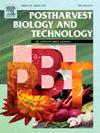Tomato Synaptotagmin F accelerates fruit ripening, shortens fruit shelf-life and increases susceptibility to Penicillium expansum
IF 6.4
1区 农林科学
Q1 AGRONOMY
引用次数: 0
Abstract
Synaptotagmins (SYTs), initially identified as calcium sensors for regulating synaptic vesicle exocytosis and endocytosis in mammalian neurons, play crucial role in biotic and abiotic stresses in plants. However, the function of SYTs in fruit ripening is unclear. In this study, a tomato Synaptotagmins gene, SlSYTF, was found to accelerate tomato fruit ripening. SlSYTF encodes an endoplasmic reticulum localized protein whose transcription is continuously enhanced during fruit ripening. Overexpression SlSYTF in tomato resulted in accelerated ripening progress, increased carotenoid content as well as decreased the firmness of tomato fruit, whereas the mutant slsytf-c exhibited the opposite phenotype. Importantly, SlSYTF could increase ethylene production by activating the expression of ethylene synthesis genes and prompt cell wall degradation by increasing pectinase and cellulase activities. Nevertheless, the accelerated cell wall degradation and thinned cuticle due to SlSYTF results in reduced shelf life and pathogen resistance. Collectively, we revealed a new SYTs gene that plays a dual role in tomato fruit ripening and pathogen response. This finding may shed new light on the relationship between maturation and immunity.
番茄 Synaptotagmin F 可加速果实成熟、缩短果实货架期并增加对扩张青霉的敏感性
突触素(SYTs)最初被认为是哺乳动物神经元中调节突触囊泡外渗和内吞的钙离子传感器,在植物的生物和非生物胁迫中发挥着至关重要的作用。然而,SYTs 在果实成熟过程中的功能尚不清楚。本研究发现番茄突触素基因 SlSYTF 能加速番茄果实成熟。SlSYTF 编码一种内质网定位蛋白,其转录在果实成熟过程中持续增强。在番茄中过表达 SlSYTF 会加速番茄果实的成熟进程,增加类胡萝卜素含量并降低果实的硬度,而突变体 slsytf-c 则表现出相反的表型。重要的是,SlSYTF 可以通过激活乙烯合成基因的表达来增加乙烯产量,并通过提高果胶酶和纤维素酶的活性来促进细胞壁降解。然而,SlSYTF 导致的细胞壁加速降解和角质层变薄会降低货架期和抗病性。总之,我们发现了一个新的 SYTs 基因,它在番茄果实成熟和病原体反应中发挥着双重作用。这一发现可能会给成熟与免疫之间的关系带来新的启示。
本文章由计算机程序翻译,如有差异,请以英文原文为准。
求助全文
约1分钟内获得全文
求助全文
来源期刊

Postharvest Biology and Technology
农林科学-农艺学
CiteScore
12.00
自引率
11.40%
发文量
309
审稿时长
38 days
期刊介绍:
The journal is devoted exclusively to the publication of original papers, review articles and frontiers articles on biological and technological postharvest research. This includes the areas of postharvest storage, treatments and underpinning mechanisms, quality evaluation, packaging, handling and distribution of fresh horticultural crops including fruit, vegetables, flowers and nuts, but excluding grains, seeds and forages.
Papers reporting novel insights from fundamental and interdisciplinary research will be particularly encouraged. These disciplines include systems biology, bioinformatics, entomology, plant physiology, plant pathology, (bio)chemistry, engineering, modelling, and technologies for nondestructive testing.
Manuscripts on fresh food crops that will be further processed after postharvest storage, or on food processes beyond refrigeration, packaging and minimal processing will not be considered.
 求助内容:
求助内容: 应助结果提醒方式:
应助结果提醒方式:


